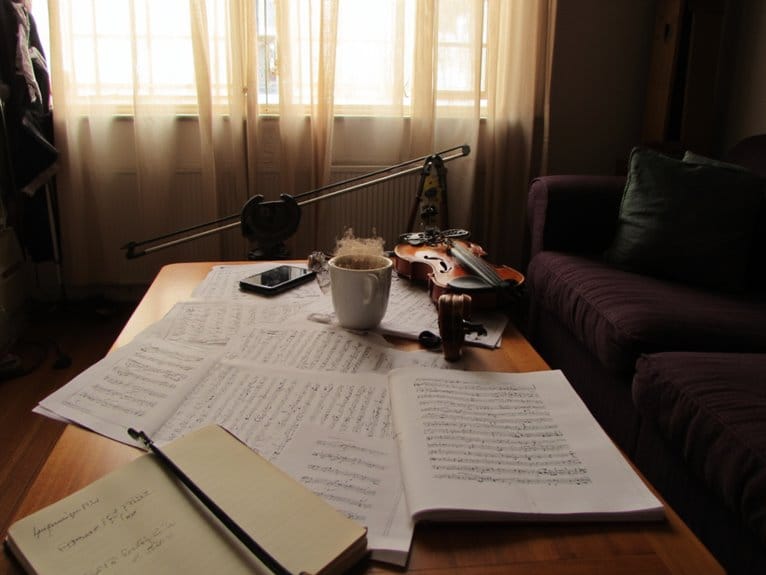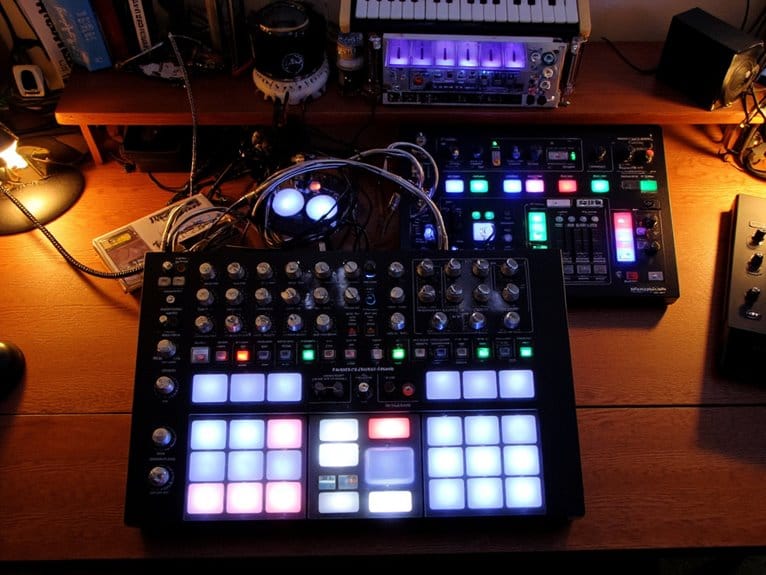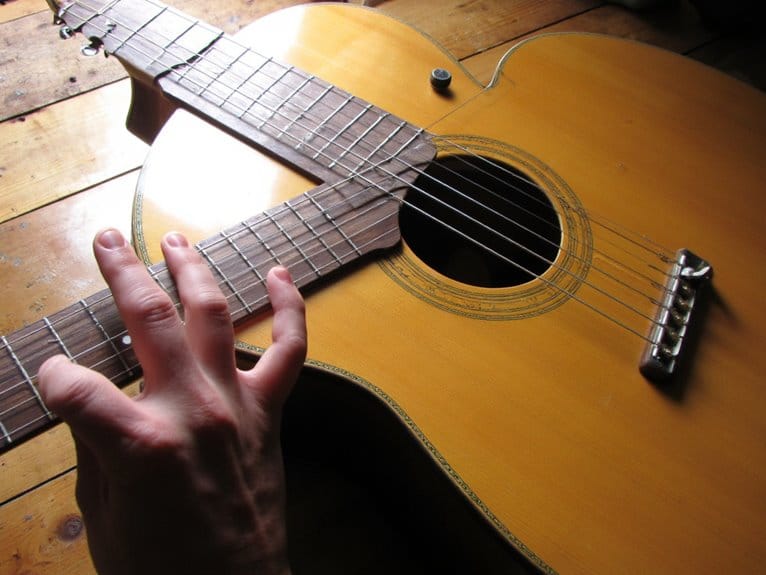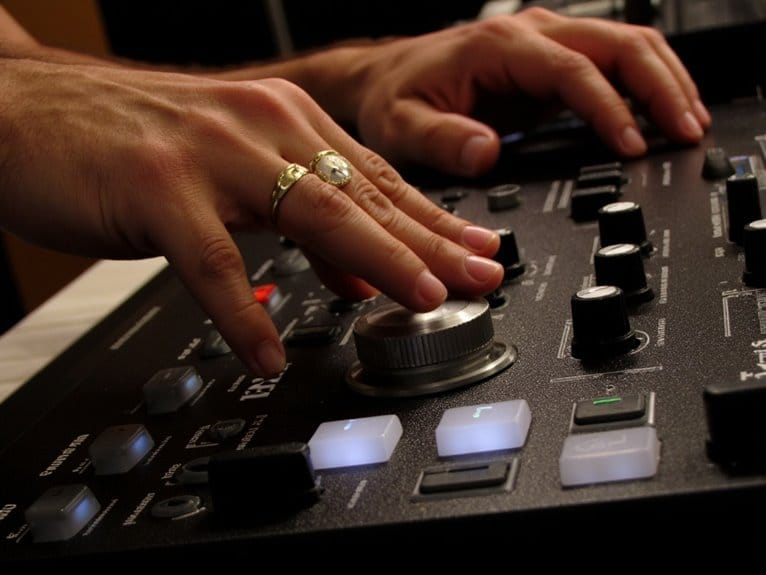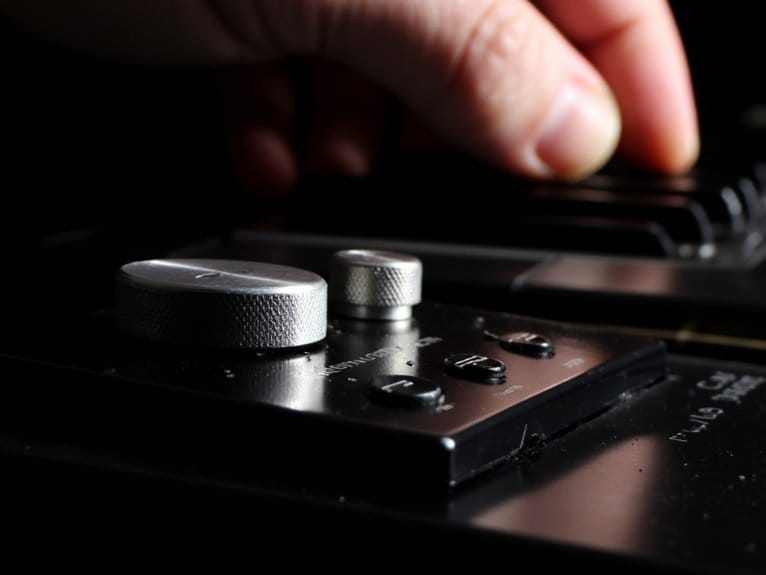Effective Practice Routines for Busy Musicians
You’ll achieve better results with 90 minutes of structured daily practice than sporadic three-hour sessions, since consistency builds stronger neural pathways than marathon efforts. Focus on four core segments: 10-minute warm-ups, technique work, repertoire development, and creative exploration, taking 5-minute breaks every 30-40 minutes to prevent mental fatigue. Set SMART goals within four-week periods, track your tempo accuracy and pitch precision using recording apps, and establish automatic habits by practicing at identical times with visible instrument placement. The specific strategies below will transform your scattered practice into a precision system.
We are supported by our audience. When you purchase through links on our site, we may earn an affiliate commission, at no extra cost for you. Learn more.
Notable Insights
- Focus on frequent, shorter sessions (30-45 minutes) rather than infrequent long practice hours for better consistency.
- Use adaptive scheduling that accommodates unexpected life changes while maintaining regular practice triggers and environmental cues.
- Structure sessions into four categories: warm-up, technique, repertoire, and creative work with specific time allocations.
- Set 1-3 SMART goals within four-week periods to maintain focus and motivation without overwhelming busy schedules.
- Establish automatic practice habits by placing instruments visibly and practicing at identical daily times for 66 days.
Building Sustainable Practice Schedules That Stick
While many musicians dream of practicing four hours daily like concert virtuosos, I’ve learned that sustainable practice schedules aren’t built on heroic time commitments but rather on consistent, intelligently structured sessions that fit your actual life.
Your ideal practice duration likely falls between 1.5 to 4 hours daily, but breaking this into shorter, focused segments prevents fatigue and improves retention. I recommend scheduling consistent practice times to establish habit formation, incorporating 5-10 minute rest intervals every 30-40 minutes to maintain concentration.
Adaptive scheduling becomes essential when life throws curveballs—flexible plans that accommodate unexpected changes improve long-term adherence. Mental preparedness through brief warm-ups and mindfulness techniques enhances session quality, while planned rest days prevent burnout and support sustained progress. Consider investing in practice equipment with dual power options to maintain flexibility whether you’re at home with an adapter or need battery-powered portability for sessions in different locations. For musicians recording their practice sessions, implementing buffer sizes between 64 to 256 samples significantly reduces audio delays and ensures accurate playback timing. For drummers, electric drum sets offer excellent practice solutions with quiet operation and portability features that support consistent training schedules. Research shows that deliberate practice requires intense mental focus, making sessions longer than one hour often counterproductive for most musicians. Just as the music industry recognizes that continuous assessment of environmental impacts drives meaningful change, regularly evaluating your practice habits ensures ongoing improvement and sustainable progress.
Setting Clear Goals to Maximize Your Practice Time
Although establishing a consistent practice schedule forms the foundation of musical progress, your efforts won’t reach their full potential without clear, purposeful goals that transform scattered practice sessions into strategic skill-building experiences.
I’ve learned that goal clarity becomes your practice compass, directing every minute toward meaningful advancement. The SMART framework—Specific, Measurable, Achievable, Relevant, Time-bound—turns vague aspirations into actionable targets. Writing down 1-3 focused goals within four-week periods prevents overwhelming dilution of effort while maintaining laser focus on priority skills.
| Skill Level | Sample Goal Examples |
|---|---|
| Beginner | Master C major scale, learn three basic chords |
| Intermediate | Complete jazz standard, improve improvisation timing |
| Advanced | Prepare recital repertoire, explore contemporary techniques |
These motivational strategies sustain momentum through realistic challenges that match your current abilities. Recording your practice sessions creates a valuable tracking mechanism that reveals progress patterns and identifies specific areas requiring additional focus.
Structuring Sessions for Maximum Impact
The architecture of your practice session determines whether you’ll stumble through disjointed exercises or experience a fluid progression that builds momentum from warm-up to creative exploration.
Effective session segmentation divides your time into four core categories: warm-up, technique, repertoire, and creative work, with durations adjusted based on your total available practice time. For a 30-minute session, I recommend allocating 5 minutes to warm-up, 10 minutes to technical exercises, 12 minutes to repertoire, and 3 minutes to creative exploration.
This balanced practice approach prevents the mental fatigue that comes from spending entire sessions on a single task. Remember to implement regular breaks every 30-45 minutes during longer sessions, and always tackle your most challenging pieces early when your concentration peaks.
Tracking Progress With Data-Driven Insights
Every serious musician I’ve worked with eventually faces the same frustrating plateau—you’re practicing diligently, yet progress feels invisible, leaving you wondering if you’re actually improving or just spinning your wheels.
That’s where quantitative analysis transforms your practice from hopeful repetition into measurable advancement. I recommend tracking tempo accuracy, pitch precision, and sight-reading speed using digital tools that record your playing, because these apps provide objective feedback on timing and intonation that your ears might miss.
Progress visualization through charts and graphs reveals patterns you’d never notice otherwise, showing weekly improvements in technical exercises while highlighting specific breakdown points that need targeted work.
Practice logs capture session duration, goals, and qualitative notes, creating a systematic record that informs smarter practice decisions and maintains accountability.
Creating Automatic Practice Habits That Last
Data reveals your progress, but transforming those insights into consistent daily action requires building practice habits that operate on autopilot, eliminating the daily negotiation between motivation and discipline.
You’ll need approximately 66 days to establish automatic behaviors, though this timeline varies greatly based on individual factors and consistency levels.
Creating effective habit triggers becomes your foundation for sustainable practice routines. Place your instrument in a highly visible location, practice at identical times daily, and establish environmental cues that automatically initiate your sessions.
These contextual anchors embed practice into your existing routines without conscious effort.
Neural reinforcement strengthens through frequent, shorter sessions rather than sporadic marathon practices. Your brain’s myelination process responds better to consistent daily engagement, building stronger neural pathways that support automatic skill execution and habit maintenance.
Professional audio interfaces with 48V phantom power enable high-quality recording during practice sessions, supporting condenser microphones that capture detailed sound for effective self-assessment and progress tracking.
Quality recording equipment with zero-latency monitoring can enhance your practice sessions by providing immediate audio feedback without delays that disrupt timing and rhythm development.
Modern USB microphones offer plug-and-play compatibility for musicians seeking convenient recording solutions during practice sessions without complex setup requirements.
Frequently Asked Questions
How Do I Maintain Practice Motivation When I’m Not Seeing Immediate Results?
You’ll maintain motivation by setting smaller, achievable goals instead of expecting immediate breakthroughs. Use progress tracking to document tiny improvements daily. Focus on your intrinsic love for music rather than external pressure.
What Should I Do if I Miss Several Days of Practice?
Don’t panic about catching up after missing practice days. Start with shorter sessions focusing on fundamentals, not marathon practices. Effective time management means gradual rebuilding—your muscles need readjustment time to prevent injury.
How Can I Practice Effectively When Traveling or Away From Home?
Pack essential travel tools like practice mutes and portable stands for mobile practice sessions. You’ll maintain consistency by scheduling brief practice blocks during downtime, using hotel rooms or quiet spaces while protecting your instrument.
How Do I Balance Practicing Multiple Instruments With Limited Time?
Focus on instrument prioritization based on your current goals and deadlines. Use effective time management by scheduling shorter, focused sessions per instrument rather than long unfocused periods. Rotate daily emphasis while maintaining consistency.
On a final note
You’ve got the framework now—sustainable schedules, clear goals, structured sessions, progress tracking, and automated habits—but implementation’s where the magic happens. I’ve watched countless musicians transform their practice from chaotic cramming sessions into efficient, results-driven routines using these exact strategies. Start with just one technique, perhaps the 15-minute focused session structure, and you’ll discover that consistent, intentional practice beats sporadic marathon sessions every time.

